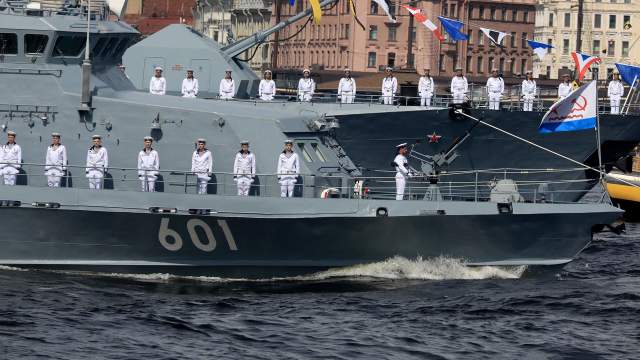An almost silent nuclear submarine, a frigate and a proven Soviet classic will pass along the Neva
On the Day of the Russian Navy, July 31, the Main Naval Parade will be held in St. Petersburg. More than 40 ships and submarines, 42 aircraft and helicopters and more than 3.5 thousand military personnel will take part in it. They will represent all fleets — from the Baltic to the Pacific. Izvestia understood what novelties and time-tested weapons the audience of the ceremony will see, what capabilities they have.
Underwater novelties
One of the most advanced nuclear submarines of the Russian Navy, the K-560 Severodvinsk of the 885 Yasen project, will stand out in the ranks of the Main Naval Parade this year. This is the lead ship of the series. And after it, at least ten attack boats of the 885M Yasen-M project will be built.
To date, these are the least noisy submarines in the entire Navy. They can both destroy enemy submarines and strike at surface ships and ground targets. Ten torpedo tubes of 533 mm caliber are located in the sides of the ship in groups of five. This solution frees the nose of the hull to accommodate the unique spherical antenna of the Irtysh-Amphora hydroacoustic complex. He "hears" any underwater object at a distance of tens of kilometers.
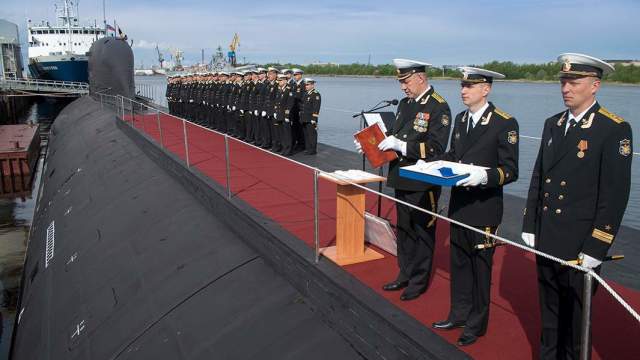
Nuclear submarine K-560 Severodvinsk of project 885 "Ash" during the ceremony of raising the St. Andrew's flag in Severodvinsk
Image source: Photo: RIA Novosti/The press service of JSC "PO "Sevmash"
In addition to torpedoes and rocket-torpedoes, the boat carries a universal launcher of the enhanced Kalibr missile system, which carries various types of ammunition in eight cells: anti-ship supersonic Onyx, cruise Calibers for firing at ships and ground targets, as well as promising hypersonic Zircon missiles. In total, the Ash ammunition can reach 32 units.
The Ash Trees have strengthened the strike potential of the fleet, and after receiving the Zircon missiles, they will become the only submarines in the world equipped with hypersonic weapons.
The second underwater nuclear—powered parade - K-156 "Boar" project 971. This is an attack submarine built in the mid-1990s, one of the best boats of the late USSR. In terms of its capabilities, it is comparable to the best American submarines of the Los Angeles type. In 2020, the Boar underwent modernization and received Kalibr cruise missiles, which can be used from four 533 mm torpedo tubes.
In addition, two 650-mm torpedo tubes with long-range torpedoes and universal long-range rocket torpedoes are installed on the boat. Several boats of the 971 project are being upgraded by Severodvinsk Sevmash software and will be delivered to the Russian Navy with updated capabilities in the next couple of years. In combination with the rest of the submarine forces, the ships of Project 971 will form the backbone of the strike forces of the Russian fleet.
There will also be two non—nuclear submarines in the parade formation - B-585 "Saint Petersburg" of project 677 and B-602 "Magadan" of project 06363. Both were developed by the St. Petersburg Central Design Bureau MT "Rubin". And if Magadan is a representative of the most advanced project of non—nuclear submarines of the previous generation, then St. Petersburg belongs to the next generation.
A low-noise multi-mode single running electric motor, a revolutionary one-and-a-half-hull design architecture for our Navy, a unique sonar system and the most advanced torpedo armament provide St. Petersburg with outstanding capabilities in a dueling situation with any other submarine.
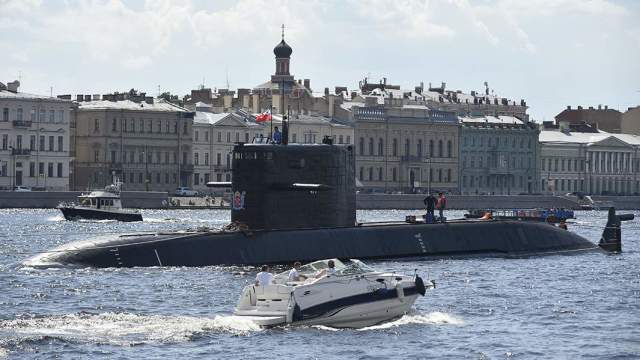
Submarine B-585 "Saint Petersburg" of project 677
Image source: Photo: IZVESTIA/Alexander Polegenko
Boats of both projects can use Kalibr-PL cruise missiles and strike ground targets at a range of up to 2.5 thousand km, as well as hit enemy ships at a distance exceeding the capabilities of torpedo weapons.
Both series are currently under construction. This makes it possible to upgrade the non-nuclear submarine forces of the fleet, which bear both the tasks of protecting the areas where nuclear "strategists" are based and operations against ground targets.
Large and small
The largest combat surface ship of the parade is the frigate Admiral Gorshkov of project 22350. They are being built in St. Petersburg in a relatively large series. They are designed to become the shock fist of the Navy on the ocean expanses. The frigate has no restrictions on the types of possible targets — it is a universal missile naval combat vehicle with the most advanced weapons.
Hypersonic missiles "Zircon" may enter the frigate's missile system in the fall of 2022. It was with the Admiral Gorshkov that flight tests of this weapon began in 2020 with launches on land and sea targets. In addition to them, the frigate can use the entire range of cruise and aeroballistic missiles of the Kalibr-NK complex to defeat land, sea and underwater targets.
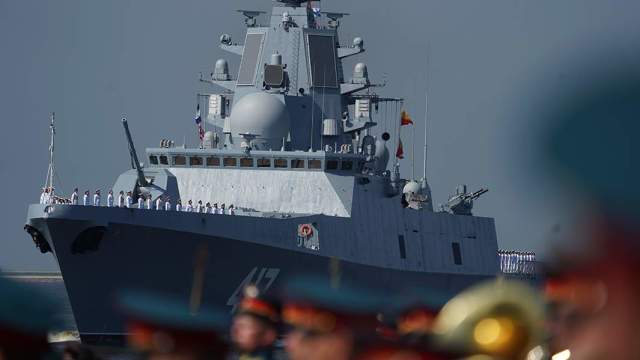
Frigate "Admiral Gorshkov" project 22350
Image source: Photo: IZVESTIA/Alexander Kazakov
The ship is also equipped with an anti-aircraft missile system of zonal defense "Redut" with a range of up to 120 km and two missile and artillery complexes "Palash", which provide defense against anti-ship missiles. A frigate can fight alone, but as part of a squadron of ships, it is, of course, more effective. The modern Russian navy can provide him with the appropriate escort.
A separate place in the parade ranks is given to the small rocket ships "Green Dol" and "Veliky Ustyug" of project 21631 "Buyan" and "Odintsovo" of project 22800 "Karakurt". These ships are united by the Kalibr-NK complex — each carries eight Kalibr missiles. The power of a single small ship's salvo is equivalent to the strike of the Iskander-M ground-based missile division.
A special ship is the Odintsovo. This is the first MRC equipped with the most modern anti-aircraft self-defense system "Pantsir-M", capable of shooting down not only airplanes and helicopters, but also anti-ship missiles, and drones, and even multiple launch rocket systems.
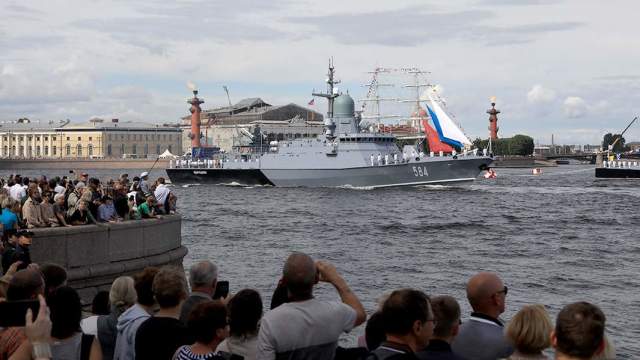
Odintsovo small rocket ship of project 22800
Image source: Photo: IZVESTIA/Sergey Konkov
All ships of these projects belong to the "river-sea" class. If necessary, they can move between the sea areas in the European part of the country without leaving the Russian territorial waters — by inland waterways.
The large landing ship (BDK) "Ivan Gren" of project 11711, as well as nuclear submarines, came to St. Petersburg from the Northern Fleet specifically to participate in the Main Naval Parade of Russia. Now it can rightfully be called the flagship of the Naval amphibious assault.
The BDK was adopted by the fleet in 2018, and its serial counterpart, Pyotr Morgunov, was commissioned two years ago. It can deliver up to 40 armored vehicles, 400 paratroopers, five Ka-29 and Ka-52K helicopters at a distance of up to 4 thousand miles and land these forces on an unprepared coast.
At the end of the current decade, the role of the flagship of the amphibious forces of the Russian fleet "Ivan Gren" will give way to a more advanced universal landing ship (UDC) "Ivan Rogov" project 23900, which has been under construction since 2020. And then the two "Ivan" together will be able to land anywhere more than 100 pieces of equipment and fifteen hundred paratroopers with more than 20 helicopters providing their landing fire support.
Dmitry Kornev
